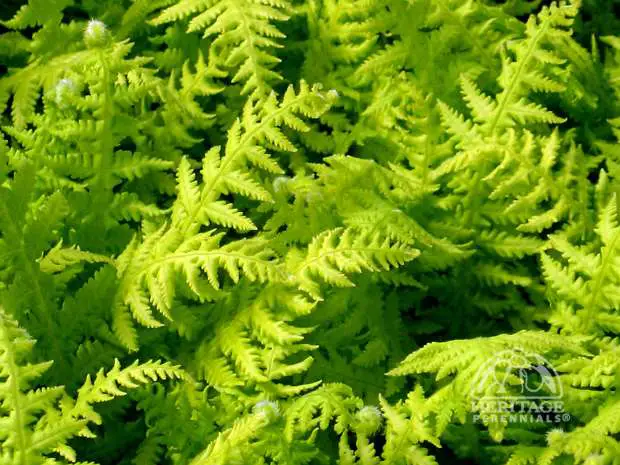Succeeding with Hardy Ferns
Perennials 101, Perennials for Special Purposes

Thelypteris decursive-pinnata
1. SOME FERN FACTS
Ferns are valuable garden plants of great dependability and beauty. Their leaves, known as fronds, can be lacy or leathery, plain green or variegated, providing a long season of interest. Rarely suffering from pests and diseases, they offer trouble-free elegance.
Ferns were tremendously popular in Victorian times, and many of the British well-to-do had ferneries — shady garden areas devoted to vast fern collections. As modern gardeners become more aware of the value of foliage texture in their landscapes, they are rediscovering the refreshing diversity of hardy ferns. Naturally inhabiting woodland areas, ferns thrive in the shade offered by trees during the heat of summer. They perform best in a moist, well drained soil, high in organic matter. Providing appropriate soil conditions for ferns will reward you with healthy, vigorous plants.
There are numerous kinds of hardy ferns available in garden centers. Many fern species are deciduous, dying back to the ground for winter. Others are evergreen, providing attractive winter foliage in the garden, or brought indoors for cut-flower arrangements.
In Zones 2 through 6 the evergreen types often become more semi-evergreen in habit. Ferns vary in texture and height as well; some forming a low spreading mound, while others create a bold upright clump. With such a range, even the smallest garden can have a woodland feeling by planting a few ferns along with other moist-shade lovers such as Hostas, Primroses and Astilbes.
2. Tips on planting and care
Fern care is relatively easy. Ferns require moist, humus rich soil. If your soil is poor, dig in 4 to 6 inches of well-rotted compost or peat moss. This will provide a loose, water-retentive soil in which ferns can thrive. Ferns do well under trees, but tree roots (especially maples and many evergreens) may rob the soil of water and nutrients. Also, rain may not penetrate the branch canopy. You may have to provide regular watering to these areas if you want to grow ferns there. This is especially critical just after planting until the ferns becomes established. It is a good idea to mulch around your ferns with compost or leaf litter once a year. This will improve the soil, keep the roots cool and help to retain moisture. Where winters are very cold, cover ferns with boughs or mulch in the fall to protect them. Evergreen ferns may look somewhat tattered by late winter; if so, trim off any unsightly foliage in early spring.
3. Some Hardy Ferns to look for:
This is just a small sampling of the hardy ferns now available. Our online Perennial Search will help you to locate many more. Simply type the word ferninto the box and click “search”.
- Northern Maidenhair Fern (Adiantum pedatum).
Native through the northern states and Canada, this forms a medium-sized mound of very delicate, lacy foliage. The leaf-stems are a striking black color.
- Dragon’s-tail Fern (Asplenium ebenoides).
The triangular fronds are tapered and toothed, giving the appearance of the dragon’s tail. These ferns form a low mound of shiny fronds, reaching 1 foot (30cm) tall. Evergreen.
- Japanese Painted Fern (Athyrium niponicum ‘Pictum’).
Only reaching 1 foot (30cm), this has beautiful low fronds highlighted in silvery gray, with purple leaf-stems. Japanese Painted fern is the most colorful hardy fern, and one of the easiest to grow. Deciduous.
- Crested Lady Fern (Athyrium filix-femina ‘Vernoniae Cristatum’). Forming dense mounds of bright green, very lacy fronds, this fern is a particularly easy variety to grow. Deciduous.
- Robust Male Fern (Dryopteris complexa ‘Robust’). A taller fern, excellent as a specimen plant. Fronds are dark green and long, arching gracefully under their own weight. A strong grower, but not invasive in the least. Deciduous.
- Shaggy Shield Fern (Dryopteris cycadina). Fronds are a light golden-green, while the undersides have interesting black scales. Evergreen in milder regions. Forms a low mound to 2 feet (60cm).
- Christmas Fern (Polystichum acrostichoides). A very familiar garden fern, native to eastern North America. Plants form a tidy, low to medium-sized clump of dark-green, leathery fronds, remaining evergreen in most regions. Tolerates summer heat and humidity.
- Autumn Fern (Dryopteris erythrosora). Evergreen in milder winter regions, the new fronds emerge a bright copper colour, contrasting with the older green fronds. Low to medium in habit, and excellent for mass planting.